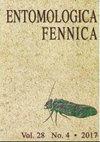Factors affecting the occurrence of bark- and wood-boring beetles on Scots pine logging residues from pre-commercial thinning
Q3 Agricultural and Biological Sciences
引用次数: 3
Abstract
A total of480 Scots pine (Pinus sylvestris L.) trees felled during pre-commercial thinning in a single stand in the Drahanska Highlands in the Czech Republic were examined for the occurrence of bark- and wood-boring beetles. Thinning was performed on different dates during 2006 and 2007 (February, May, August and November). Half of the felled trees were cut into 1 m-long sections, and the rest were left whole. The fauna inhabiting the logging residues were investigated by peeling off the bark ofthe felled trees during the first six months of the vegetative period following felling. The studied logging residues hosted species-rich assemblages of bark- and wood-boring beetles (28 species identified), including numerous populations of several pest species (Pityogenes chalcographus, Tomicus minor and Tomicus piniperda). The occurrence of species was significantly affected mainly by the part of the tree and its diameter and bark thickness and by the felling date and post-felling cutting of the trees.影响苏格兰松商业化前疏伐残留物上钻树皮和钻木甲虫发生的因素
在捷克共和国Drahanska高地的单一林分中,对在商业前疏伐期间被砍伐的480棵苏格兰松(Pinus sylvestris L.)进行了树皮和木材蛀虫的调查。在2006年和2007年的不同日期(2月、5月、8月和11月)进行了稀释。被砍伐的树木中有一半被切成1米长的部分,其余的则保持完整。在采伐后植被期的前6个月,通过剥去被采伐树木的树皮,调查了栖息在采伐残余物中的动物。所研究的伐木残留物中含有丰富的树皮和木材蛀虫组合(已鉴定的28种),包括几种害虫(Pityogenes chalcographus, Tomicus minor和Tomicus piniperda)的大量种群。物种的发生主要受树木的部位、直径和树皮厚度以及采伐日期和采伐后的树木数量的显著影响。
本文章由计算机程序翻译,如有差异,请以英文原文为准。
求助全文
约1分钟内获得全文
求助全文
来源期刊

Entomologica Fennica
生物-昆虫学
CiteScore
1.20
自引率
0.00%
发文量
0
审稿时长
>12 weeks
期刊介绍:
Cessation.Information not localized
 求助内容:
求助内容: 应助结果提醒方式:
应助结果提醒方式:


